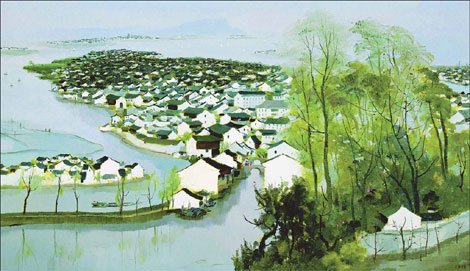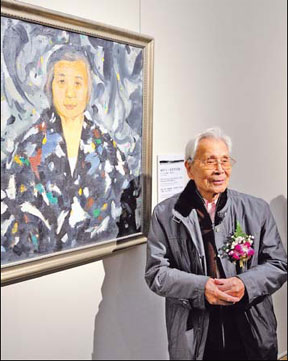|

The Hometown of Lu Xun, 1978, by Wu Guanzhong, ink and color on paper, from the collection of Beijing Lu Xun Museum. Provided to China Daily
|
Wu Guanzhong died in June, before a major retrospective of his work in Hangzhou that shows him to be one of the most popular and successful artists of his generation. Zhu Linyong reports
Veteran painter Wu Guanzhong (August, 1919-June, 2010) died five months before the most comprehensive retrospective exhibition of his art. The show, which took four years to prepare, opened on Nov 20 at Zhejiang Museum of Art in Hangzhou, capital of the East China province.
Co-organized by the Ministry of Culture and the museum, the exhibition comprises 350 ink, oil and pencil sketches, alongside videos and slides "to illustrate the lifelong pursuit of an artist who won both critical accolades and popular admiration", says museum director Ma Fenghui.
It is the first time such a large scale exhibition of Wu's works have gone on show, with most of the exhibits on loan from nine domestic and overseas museums.
All of the exhibits are Wu's donations to these museums, as he insisted on having his art "enjoyed by all rather than individual collectors".
According to Wu Keyu, Wu Guanzhong's eldest son, these are the "most representative works of my father's artistic merits, as he always insisted on donating his best works to public museums".
A series of lectures will be staged to give the general public an insight into the artist's works, organizers say.
"Arguably one of the most popular and successful artists of his generation, Wu strove for a new style which bridges the East and the West," says Szeto Yuen-kit, curator with Hong Kong Museum of Art, a recipient of some of Wu's last works, done months before he died in a Beijing hospital on June 25.
"His art transcends the barriers of geographic locations, races, languages and even cultures and appeals to both Chinese and international audiences."
Wu, from Yixing, Jiangsu province, initially trained as an engineer.
|

Wu with his portrait of his wife at the National Art Museum in Beijing, in 2009. Xinhua
|
However, upon visiting Hangzhou National Art College, headed by master painter Lin Fengmian (1900-1991), Wu devoted his life to painting.
Wu graduated from Hangzhou National Art College in 1942 and became one of Lin's best-known students.
He went to France in 1947 and studied figure painting at the Ecole Nationale Superieur des Beaux-arts in Paris, on a national scholarship.
Returning to China in 1950, he took a series of teaching posts at various academies, including the Central Academy of Fine Arts in Beijing, Tsinghua University and Beijing Arts School.
His early works, depicting landscapes in southern China are highly poetic; special emphasis was given to the mixing and matching of points, lines and surfaces in his compositions.
His well-conceived outdoor landscapes involve selections of different vantage points, as the artist sought to present nature through painted forms, explains National Art Museum director Fan Di'an, who delivered a lecture on the weekend in Hanghzou.
Since Wu's death, numerous people have written about their impressions of Wu and his art.
Some praise Wu for bringing modern Chinese art to the world. Early in 1992, Wu held a solo show at the British Museum. This was followed by the inclusion of his works at many other public museums in Europe and Asia.
Others call Wu "an outspoken public figure and an independent thinker".
Wu openly expressed his disgust with the rigid, bureaucratic Chinese Artists Association and the Academy of Fine Arts system, and once labeled Xu Beihong (1895-1953), a major advocate of Socialist Realism, "an art illiterate".
As for the critics, Wu Wei, from Shenzhen, describes Wu as "a self-indulgent artist" who only acquired a shallow understanding of both Chinese calligraphy and Western Abstract art.
Meanwhile, Cao Peng, editor-in-chief of Chinese Calligraphy and Painting, says: "Wu's innovative modern art falls short of being real masterpieces."
Wu failed to advance the styles spearheaded by Western artists such as Jackson Pollock, Mark Tobey and Miro, Cao adds.
(China Daily 11/26/2010 page18)
|


